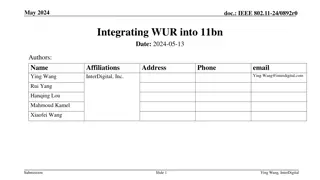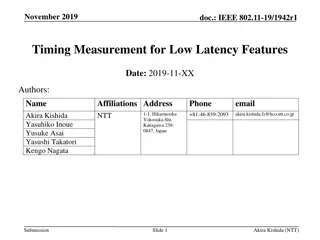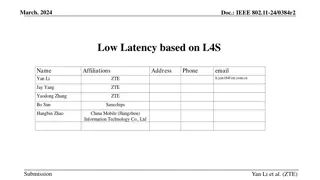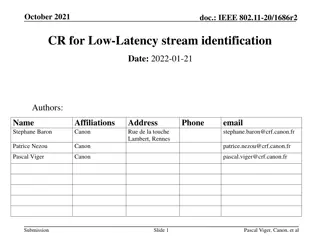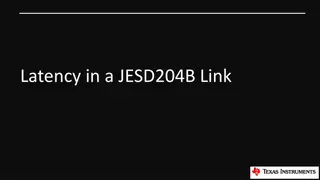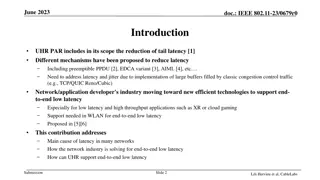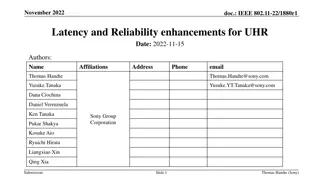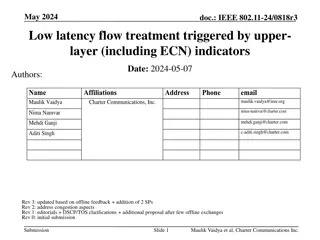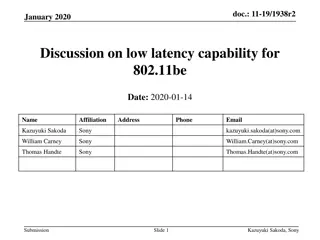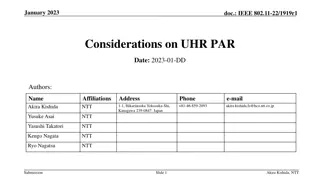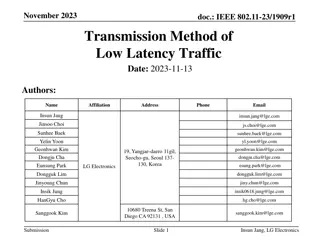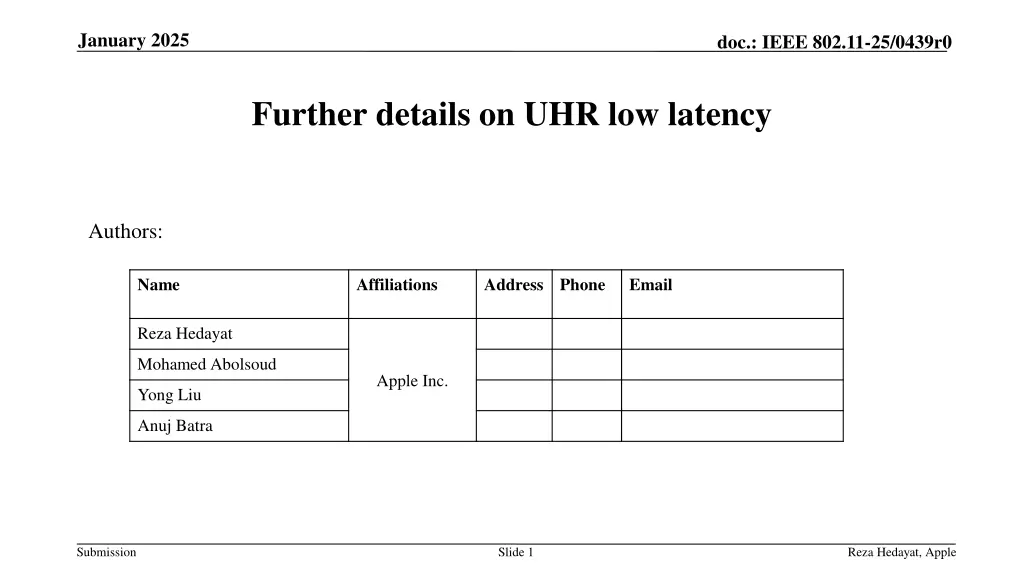
Understanding IEEE 802.11-25/0439r0 for Low Latency Networking
Explore the details of IEEE 802.11-25/0439r0 document focusing on Ultra High Rate (UHR) low latency. The document discusses LL proposals, LL signaling, and subsequent actions by the TXOP-owner in response to LL indications. Gain insights into LL request signaling, LL indication types, and the proposal for LL signaling carried in ICR/M-BA.
Uploaded on | 0 Views
Download Presentation

Please find below an Image/Link to download the presentation.
The content on the website is provided AS IS for your information and personal use only. It may not be sold, licensed, or shared on other websites without obtaining consent from the author. If you encounter any issues during the download, it is possible that the publisher has removed the file from their server.
You are allowed to download the files provided on this website for personal or commercial use, subject to the condition that they are used lawfully. All files are the property of their respective owners.
The content on the website is provided AS IS for your information and personal use only. It may not be sold, licensed, or shared on other websites without obtaining consent from the author.
E N D
Presentation Transcript
January 2025 doc.: IEEE 802.11-25/0439r0 Further details on UHR low latency Authors: Name Affiliations Address Phone Email Reza Hedayat Mohamed Abolsoud Apple Inc. Yong Liu Anuj Batra Submission Slide 1 Reza Hedayat, Apple
January 2025 doc.: IEEE 802.11-25/0439r0 Background: Overview of LL proposals During a TXOP, a TXOP-responder sends low latency (LL) indication to the TXOP-owner LL request signaling: May be carried in a CRF, e.g. BA May be carried in an ICR, e.g. M-BA Types of LL indication [1,2]: Request to transmit data to the TXOP-holder Request to opt out of the TXOP LL session During a LL session, AP/non-AP STA TXOP-owners expect to receive LL indication Submission Slide 2
January 2025 doc.: IEEE 802.11-25/0439r0 Signalling for LL indication 1 LL signaling in CRF BA: using currently available bits (5 reserved bits) However, these reserved bits may not be suitable to be used for LLI M-BA: use M-BA instead of BA to carry LLI Currently M-BA can be used for acknowledging MPDUs carried in multi-TID single-STA A-MPDUs. 9.3.1.8.6: The Multi-STA BlockAck frame is supported if either UL MU or multi-TID A-MPDU operation is 5 supported and acknowledges MPDUs carried in an HE TB PPDU or multi-STA multi-TID, multi-STA single-TID, or single-STA multi-TID A-MPDUs. Spec change: need to allow the use of M-BA for single-TID A-MPDUs The goal is to accommodate the LL signaling indication in M-BA regardless if the M-BA acts a control response frame (i.e. a block acknowledgment to an A-MPDU) or as ICR (as a response to an ICF) Submission Slide 3
January 2025 doc.: IEEE 802.11-25/0439r0 Signalling for LL indication 2 Proposal: LL signaling carried in ICR/M-BA The LL signaling is always present, during a LL session, regardless if the STA has a request for LL transmission In other words, the LL request indicates no-request or indicates a request for reverse direction As a result, the provided feedback is a fixed-size feedback whose length is known to the receiving STA A feedback Per AID TID Info field carries LL signaling The Starting Sequence Control and Block Ack Bitmap to carry the type and the LL request and its attributes. The Feedback Type field (located in B12 to B15 of the Block Ack Starting Sequence Control) is set to 1 Two or more bits in Block Ack Bitmap field is defined to provide the low latency need Submission Slide 4
January 2025 doc.: IEEE 802.11-25/0439r0 Subsequent actions by the TXOP-owner Once the TXOP-owner receives the LL signaling in an ICR, it should consider the request in subsequent actions An AP TXOP-owner may consider the received LL signaling in triggering the requesting STA A TXOP-owner may provide reverse direction grant to the requesting STA, per baseline RD procedure An AP TXOP-owner may share the TXOP with the the requesting STA, via the baseline TXS procedure Submission Slide 5
January 2025 doc.: IEEE 802.11-25/0439r0 Summary This contribution proposes to carry low latency indication in an ICR Given the use of M-BA as ICR, we propose to use M-BA to carry the low latency indication Submission Slide 6
January 2025 doc.: IEEE 802.11-25/0439r0 Strawpoll Define or improve an existing mechanism so that a non-AP STA that is a TXOP responder can indicate its low latency needs (for traffic between the TXOP responder and the TXOP Holder) in a control response frame that is an M-BA frame. The TXOP holder should consider the indication in determining subsequent actions. Subsequent actions related to this indication are out of the scope of the standard. Note: whether an AP can Indicate its Low latency needs is TBD The Low Latency Indication is included in the Feedback field of the Feedback Per AID TID Info field (the one that carries control feedback). The Feedback Type field (Located in B12 to B15 of the Block Ack Starting Sequence Control) is set to 1 Note: Feedback Type field set to 0 is used for DUO feedback. TBD bits in Block Ack Bitmap field is defined to provide the low latency need Submission Slide 7
January 2025 doc.: IEEE 802.11-25/0439r0 References [1] 24-389r0, Preemption for Low Latency, Mohamed Abouelseoud [2] 24-168r0, TXOP Preemption in 11bn, Kiseon Ryu Submission Slide 8










